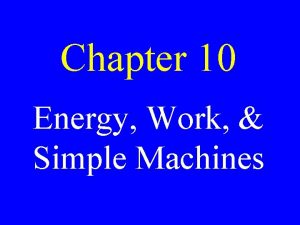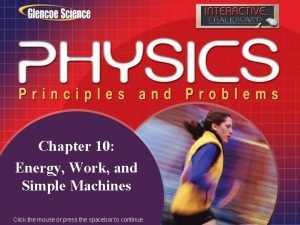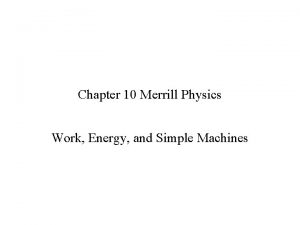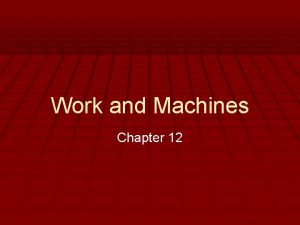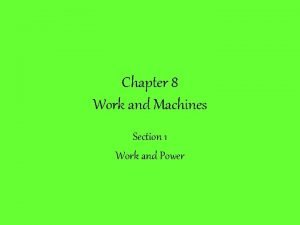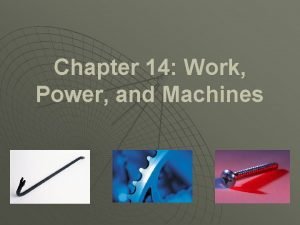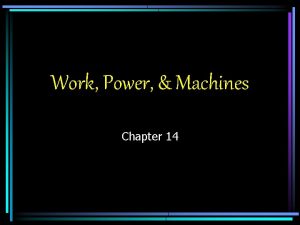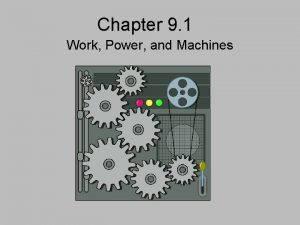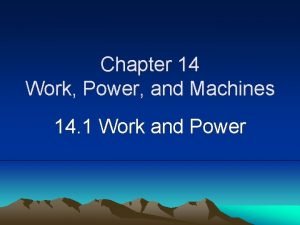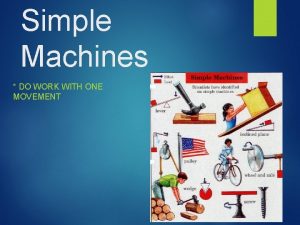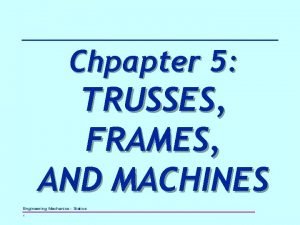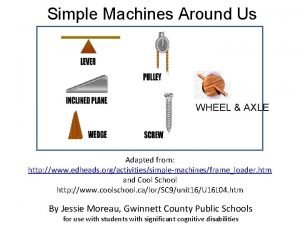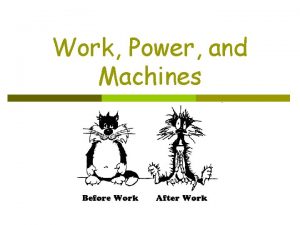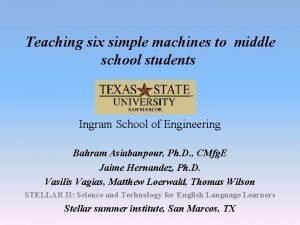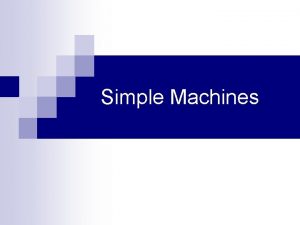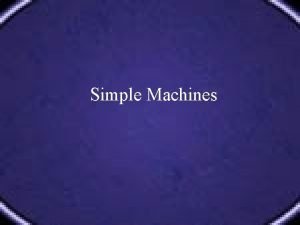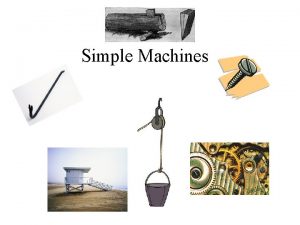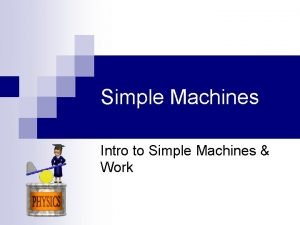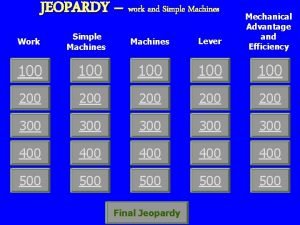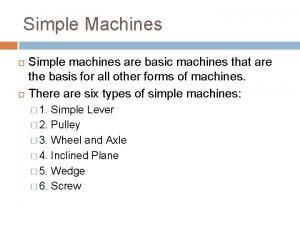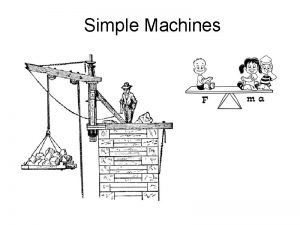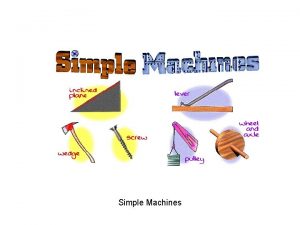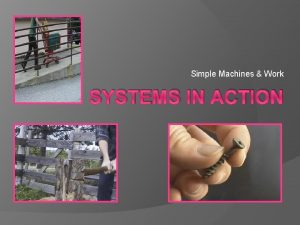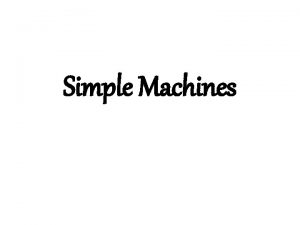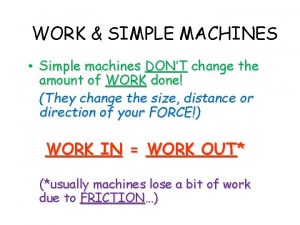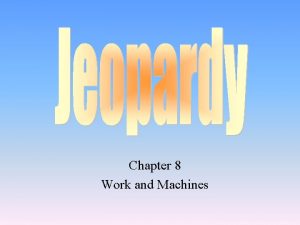Work and Simple Machines Work and Simple Machines


























- Slides: 26

Work and Simple Machines

Work and Simple Machines 2

Work Ø Work: l l l Mechanical work-most familiar form of work The force exerted over a given distance W=Fd • This is a scalar quantity because direction is not given • Work can be positive, negative or zero

What is work? Ø In science, the word work has a different meaning than you may be familiar with. Ø The scientific definition of work is: using a force to move an object a distance (when both the force and the motion of the object are in the same direction. ) 4

What’s work? ØA scientist delivers a speech to an audience of his peers. Ø A body builder lifts 350 pounds above his head. Ø A mother carries her baby from room to room. Ø A father pushes a baby in a carriage. ØA woman carries a 20 kg grocery bag to her car? 5

What’s work? ØA scientist delivers a speech to an audience of his peers. No Ø A body builder lifts 350 pounds above his head. Yes Ø A mother carries her baby from room to room. No Ø A father pushes a baby in a carriage. Yes ØA woman carries a 20 kg grocery bag to her car? No 6

Work or Not? Ø According to the scientific definition, what is work and what is not? l l a teacher lecturing to her class a mouse pushing a piece of cheese with its nose across the floor 7

Work or Not? Ø According to the scientific definition, what is work and what is not? l l a teacher lecturing to her class a mouse pushing a piece of cheese with its nose across the floor 8

9

Mechanical work Ø Positive mechanical work: this is when the force acts on a system in the same direction as the system’s motion l l l In other words- work is positive when the force applied on the system is greater than the force exerted by the system If I push a box and it moves in the direction I have pushed it then I have a positive mechanical work, if it does not move work is zero A SYSTEM MUST MOVE FOR WORK TO BE DONE (on it)

Formula for work Work = Force x Distance Ø The unit of force is newtons Ø The unit of distance is meters Ø The unit of work is newton-meters Ø One newton-meter is equal to one joule Ø So, the unit of work is a joule 11

W=FD Work = Force x Distance Calculate: If a man pushes a concrete block 10 meters with a force of 20 N, how much work has he done? 12

W=FD Work = Force x Distance Calculate: If a man pushes a concrete block 10 meters with a force of 20 N, how much work has he done? 200 joules (W = 20 N x 10 m) 13

Calculating Work Ø London’s Great Clock mechanism is run by a falling weight, which turns the many gears that position the hands. The 2490 N (560 lb) clock weight has to be periodically wound up by an electric winch. Assuming the weight is raised 53 m and the winch exerts a force equal to the clock weight, how much work does the winch do on the weight? l l l W=Fd W=? F= 2490 N d= 53 m W= (2490 N)(53 m) • 131, 970 N m • (2490 kg m/s 2)(53 m) • 131, 970 kg m 2/s 2 l W= 130, 000 J

Check for Understanding 1. Two physics students, Ben and Bonnie, are in the weightlifting room. Bonnie lifts the 50 kg barbell over head (approximately. 60 m) 10 times in one minute; Ben lifts the 50 kg barbell the same distance over his head 10 times in 10 seconds. Which student does the most work? Which student delivers the most power? Explain your answers. 15

Ben and Bonnie do the same amount of work; they apply the same force to lift the same barbell the same distance above their heads. Yet, Ben is the most powerful since he does the same work in less time. Power and time are inversely proportional. 16

2. How much power will it take to move a 10 kg mass at an acceleration of 2 m/s/s a distance of 10 meters in 5 seconds? This problem requires you to use the formulas force, work, and power all in the correct order. Force=Mass x Acceleration Work=Force x Distance Power = Work/Time 17

2. How much power will it take to move a 10 kg mass at an acceleration of 2 m/s/s a distance of 10 meters in 5 seconds? This problem requires you to use the formulas force, work, and power all in the correct order. Force=Mass x Acceleration Force=10 x 2 Force=20 N Work=Force x Distance Work = 20 x 10 Work = 200 Joules Power = Work/Time Power = 200/5 Power = 40 watts 18

Power Ø Power is the rate of doing work l l P=W/Δt Watt (W)- SI unit for power • W= J/s l Newton’s 2 nd law of motion states that if you exert more force you will have a greater acceleration for a given mass; therefore you have a faster speed in less time • This means that a larger engine can do more work in a shorter interval than a smaller engine= the larger engine produces more POWER

Power Ø Power is the rate at which work is done. Ø Power = Work*/Time *(force Ø The x distance) unit of power is the watt. 20

Calculating Power Ø The electric winding mechanism in the Great Clock takes about 40 min. to rewind the clock weight cable. Refer back to the Great Clock force example, then calculate the power of the electric winch. l l P=W/Δt P=? W= 131, 000 J Δt= 40 min • 40 min(60 s/min)= 240 s l P= 131, 000 J/(240 s) • • 545 J/s 545 kg m 2/s 545 J/s 545 W

Simple Machines and Efficiency Ø Simple machines: a basic mechanical device that either reduces effort or increases the magnitude of motion for a given input motion when doing a certain amount of work. l A tool compose of basic mechanical parts that is to reduce effort or increase amount of motion • • Levers Wheels and axles Gears Pulleys Inclined planes Wedges Screws

Efficiency of Simple Machines Ø Because simple machines do not create energy, you cannot get more work out of something than the amount of work you put into it. l Most often you must put more work into a system than the work done by the system Ø Efficiency= is a percentage of how well the simple machine does its job

Efficiency Ø We said that the input force times the distance equals the output force times distance, or: Input Force x Distance = Output Force x Distance However, some output force is lost due to friction. Ø The comparison of work input to work output is called efficiency. Ø No machine has 100 percent efficiency due to friction. 24

Efficiency Ø Efficiency= Wout Win X 100%

History of Work Before engines and motors were invented, people had to do things like lifting or pushing heavy loads by hand. Using an animal could help, but what they really needed were some clever ways to either make work easier or faster. 26
 Section 4 review physical science
Section 4 review physical science Differentiate between simple machine and compound machine
Differentiate between simple machine and compound machine Chapter 10 energy, work and simple machines answer key
Chapter 10 energy, work and simple machines answer key Energy work and simple machines chapter 10 answers
Energy work and simple machines chapter 10 answers Chapter 10 work energy and machines
Chapter 10 work energy and machines How does mechanical advantage work
How does mechanical advantage work Section 1 work and machines
Section 1 work and machines Chapter 14 work power and machines
Chapter 14 work power and machines Chapter 14 work power and machines
Chapter 14 work power and machines Describing energy section 2 answers
Describing energy section 2 answers Work power energy and machines
Work power energy and machines Work power and machines
Work power and machines Work power and machines
Work power and machines How do machines make work easier
How do machines make work easier What are machines that work with one movement?
What are machines that work with one movement? Advantages and disadvantages of simple machines
Advantages and disadvantages of simple machines Determine the force in each member of the truss.
Determine the force in each member of the truss. Wheel and axle simple machines
Wheel and axle simple machines Wheel and axle examples around the house
Wheel and axle examples around the house Find the efficiency of a machine that does 800 j
Find the efficiency of a machine that does 800 j What is a slogan?
What is a slogan? Wedges are used to split
Wedges are used to split Example of inclined plane
Example of inclined plane A watch simple machine
A watch simple machine Two inclined planes put together back to back
Two inclined planes put together back to back What type of simple machine is a lawn mower
What type of simple machine is a lawn mower Conclusion of simple machine
Conclusion of simple machine


